Tonight, the BBC broadcast the first episode of The Great British Story: a People's History. The first programme, Britannia, dealt with the period following the fall of the Roman Empire. Throughout the Dark Ages, civilisation clung on in the western fringes of Britain as the east coast was invaded by the Anglo Saxons. The programme followed the voyage of St Columba from Ireland to Iona off the west coast of Mull. He brought Christianity into the northern land of the Picts (who had never been part of the Roman Britain having been isolated by first the Antonine, then the Hadrian walls).
St Columba had founded religious settlements on many of the islands he stopped at on his route north. The programme showed the ancient Celtic Christian carved stone crosses that still stand on the islands of Islay and Oronsay. Standing at the foot of these wonderful crosses, which are worn by the gales of 1,200 winters, is a humbling experience.
The above photo is of one of the crosses of Oronsay. It was shown for all of several seconds. I was quite pleased. It was one of mine!
Imagine you are at the edge of the sea on a day when it is difficult to say where the land ends and the sea begins and where the sea ends and the sky begins. Sea kayaking lets you explore these and your own boundaries and broadens your horizons. Sea kayaking is the new mountaineering.
Showing posts sorted by date for query columba. Sort by relevance Show all posts
Showing posts sorted by date for query columba. Sort by relevance Show all posts
Friday, May 25, 2012
Thursday, May 13, 2010
Egalitarian cruising on the Clyde
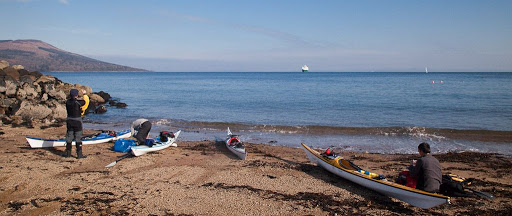
After arrival at Brodick, we trollied the kayaks off the ferry and turned hard left at the top of the ramp. This took us to a little beach of reddish Arran sand.
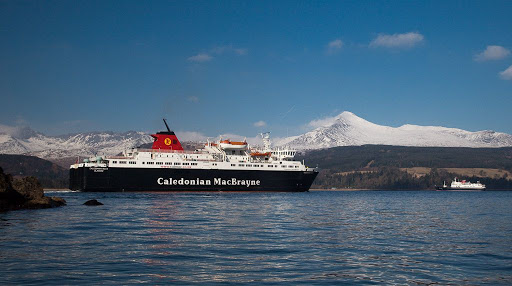
We were on the water quickly, almost as soon as the MV Caledonian Isles took to turn around.
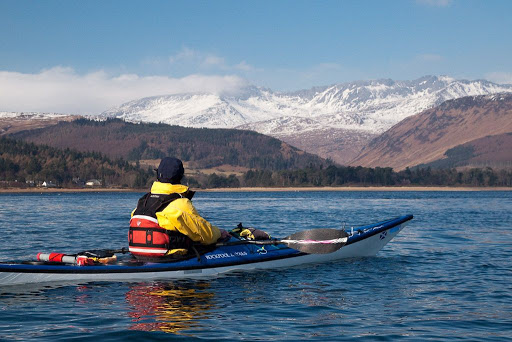
We launched into light winds and flat water which was in total contrast yo the conditions on the far side of the Clyde. We had not only made the right navigational decision, we had enjoyed a nutritious breakfast on board the ferry!
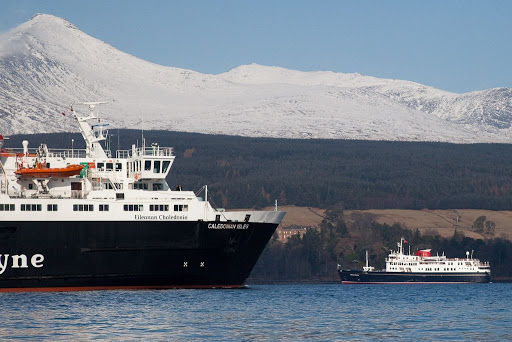
Beyond the MV Caledonian Isles we spotted the MV Hebridean Princess at anchor on the other side of Brodick Bay.
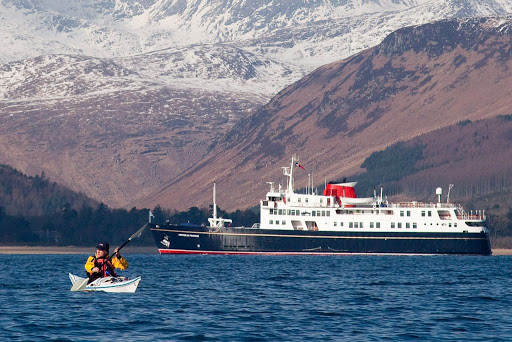
The MV Hebridean Princess is a former CalMac ferry that has been converted into a small luxury cruise liner. Don't expect to get much change from £2,500 per week in the cheap cabins. However, I understand the cuisine is in a different league to the fare we enjoy on the Arran ferry! Note the freshly painted navy blue hull which was previously black. Hebridean Princess has just undergone a major refit and this was her first outing in her smart new livery.
She was built in 1964 and, as MV Columba, she served on many routes out of Oban. Latterly she was a relief vessel for more modern RoRo ferries. When she was sold to Hebridean Island Cruises in 1988, she was the last hoist loading ferry in CalMac's Western Isles fleet. Originally she took 50 cars and 870 passengers. In her current role she carries only 49 passengers.
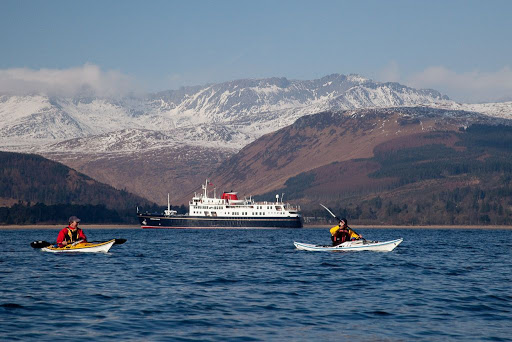
Cruising on the Clyde can be enjoyed by rich and poor, it's a very egalitarian activity.
We were looking forward to our yummy SPAM sandwiches, here is what those cruising on Hebridean Princess could look forward to:
Fresh Hand Dived Scallops
With a Thai green curry sauce
Isle of Mull Cheddar Cheese and Red Onion Tart
Carrot and Orange Soup
——‡——
Fresh Fillet of Sea Bream, Savoury Pancake
With red pepper dressing and sautéed greens
Guinea Fowl with a Herb Mash and Ribbons of Courgette
——‡——
Chocolate Nemesis with Crème Chantilly
And mint syrup
Strawberry Pavlova with a Duo of Coulis
Selection of Cheeses
——‡——
Coffee and Petits-fours
Will be served in the Tiree Lounge, the Conservatory and the Look Out Lounge
YUM YUM YUM!
Monday, October 05, 2009
The crosses of Oronsay

Walking up to Oronsay House, I asked Mrs Colburn if it was easy to get to the Oronsay Cross.
"You will find two crosses very easily, they are just beside the Priory."
"Oh, I had wondered if we might have passed the old stump of a cross down by the dunes." I replied.
Without a hint of irritation, Mrs Colburn quietly answered "That 'old stump' is the memorial I erected to the memory of my dear husband in the Millennium year."
Oops! "Sorry!"
She continued "I do hope you enjoy your visit, it's such a nice day and there have been so few like it this year."

The Great Cross of Oronsay stands inconspicuously against the farm buildings at the back of the Priory graveyard. It is finely carved on both sides and is thought to have come from Iona.

It has suffered from the weathering of five centuries but this drawing, which was published in Thomas Pennent's, A Tour in Scotland and Voyage to the Hebrides, 1772, shows the west face in detail, when it had been standing for only 272 years. The inscription reads:
+HEC EST CR/UX COLINI F/ILII CRISTI/NI M(EIC)DUFACI
'This is the cross of Colinus (Malcolm), son of Christinus MacDuffie
It was carved for Malcolm MacDuffie, the Lord of Colonsay, some time after 1472 and erected before 1500.

This is the beautiful east face of the Oronsay Cross. Next to the Kildalton Cross, on nearby Islay, it is one of the finest crosses in all of SW Scotland.

Another interesting, but older, cross stands on a little knoll to the east of the Priory. In 1881 just the shaft was standing and the present head of the cross lay on the ground beside it. There is some doubt as to whether this is the original head but it has now been replaced atop the shaft.

It is decorated by a rather portly and smiling figure.

From the grounds of the Priory, you can look out over the sea to Jura, Islay and Ireland. It is said that St Columba, who had been banished from Ireland, landed here but proceeded to Iona because he could still see his homeland from Oronsay.
Saturday, October 03, 2009
A reluctant visitor to the Priory, Oronsay (not London).

When I first mentioned to David that I wanted to visit the Oronsay Priory, he became quite distressed.
"They'll never let us out, we'll need to go into rehab and walk the twelve steps!"
"Relax David, its not the Clinic, it's just a very well preserved religious complex."
So we found ourselves approaching the beautifully maintained grounds of the Oronsay Priory.

The buildings date from the mid 1300's but there may have been a chapel here since St Columba's time. The Priory was founded by the Lords of the Isles and became a centre for religious sculpture until about 1500. Some say St Oran gave his name to Oronsay but I rather doubt this as Oronsay is quite a common name for tidal islands on the west coast. It comes from the Old Norse and means island of the ebb tide which is exactly what Oronsay is. You can walk to it from neighbouring Colonsay at low tide.

It is one of the best preserved medieval religious buildings in Scotland. It was too remote to be destroyed in the Reformation, like many of its more accessible contemporary religious buildings.

Although there are no traces of its roofs, the walls, including those of the cloisters, are still in remarkably good repair.

Fortunately for David, our departure from the Priory was unhindered by a locked door. He took a deep breath, followed by a great sigh of relief.
Monday, August 18, 2008
The State of Texa

The island of Texa lies just a kilometer off the SE coast of Islay in the Inner Hebrides of Scotland. While we were cruising down Texa's west coast we spied two gable ends high on the hill above us.

We landed at a little quay below the building. Famished and quite exhausted by our exertions since second breakfast, we decided to partake of a long and leisurely third breakfast prior to any exploration of the isle.
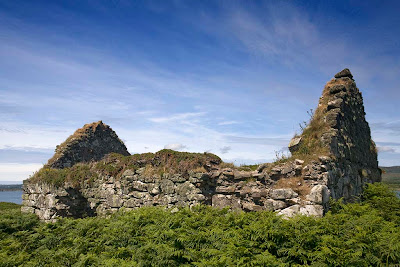
Pushing our way through shoulder high bracken, we made our way up to the ancient lichen encrusted walls. It turned out to be a chapel which was built in the 14th century. St Kenneth(whose chapel we visited last year on lovely Inch Kenneth) was a friend of St Columba and stopped off on Texa while travelling between Iona and Ireland. It is likely that the current chapel was built on the site of an earlier chapel dating from St Kenneth's time.
Texa remained inhabited until the 19th century and its population were known as Texans. Not many people know that St Kenneth was a Texan.
Tony, David and myself decided we would try and head out west round Islay's Mull of Oa. Billy and Mair decided to explore Kilnaughton Bay and Port Ellen. Given how long we had dallied, the approaching weather front and how the tide was running, the latter option was to prove eminently more sensible.
13/07/2008
Saturday, November 17, 2007
The foundation of St Oran's Chapel and voices of ancient saints

The oldest building in the grounds of Iona Abbey is St Oran’s chapel. It stands on the site of Reilig Odhrain, or St Oran’s shrine, around which is an ancient burial ground containing the remains of many kings from Scotland Norway, Ireland, Northumberland and Man. The early Christians in Ireland and Scotland did not practice their religion in the same way as that of Rome. Indeed Iona had been a sacred place to the Druids for generations before St Columba’s time. There is a grim legend attatched to the building of the original Reilig Odhrain which hints that there was perhaps a long and drawn out transition between Druidism and Christianity.
The following account was quoted by Macleod Banks in 1931. Her source was a Dr Maclagan of Clachan, Kintyre in 1894.
“When this chapel was in the course of erection, no matter what they would do or how well the work was done, every morning all that had been built the previous day was found thrown down. At last a voice came to St Columba, telling him that the only way to get the chapel completed was to bury a living man under its foundation; without that, the voice said the chapel could never be finished. Columba decided that no one could be better to put under the foundation than his own son, and accordingly got him buried at once and proceeded to build on his top. One day, however, Odhran raised his head, and pushing it through the wall, said, - “There is no Hell as you suppose, nor Heaven that people talk about.” This alarmed St Columba, in case Odhran should communicate more secrets of the other world, and he had the body removed at once and buried in consecrated ground, and St Odhran never again troubled anyone.”
We looked through the door into the darkness within. Only the glint of a gilded Celtic cross on the altar was visible. A light breeze rustled round the door and we thought we heard whispering voices echoing round the dark walls of the chapel's interior. It sounded like it might have been only a house martin's nest but we decided that we did not want to hear what St Oran might have to say to us. We chose not enter and instead paid our respects to St Oran in the light of the summer evening. Then, in the gathering dusk, we left Reilig Odhrain for Martyr's Bay where our sea kayaks lay waiting to carry us back across the Sound of Iona. Our visit had been undistubed by the sound of the voices of either day visitors or ancient saints.
19/07/2007
A Hebridean Version of Colum Cille and St. Oran [Mrs.] M. Macleod Banks, Folklore, Vol. 42, No. 1 (Mar. 31, 1931), pp. 55-60
Friday, November 16, 2007
Iona Abbey

The current day Iona Abbey is the reconstructed ruin of a Benedictine Abbey which dates from about the 13th century. St Columba had established a monastery here in 563AD but his buildings were of wood. At one time the monastery was one of the largest Christian centres in Europe. The Abbey was sacked in 1560 during the Scottish Reformation. It lay derelict until its restoration started in 1938.
St Columba was not the first saint to bring Christianity to Scotland. St Ninian established a mission at Whithorn in Galloway in 397AD.
The magnificent carved Celtic cross at the Abbey door is a replica of St John's cross, the broken remains of which are displayed in the Infirmary Museum at the rear of the Abbey.

Nearby St Martin's cross still stands. It dates from the eighth century.

By arriving late in the day by sea kayak, we were the only visitors . As we wandered round these ancient stones we experienced the peace of Iona.
19/07/2007
Sunday, September 09, 2007
The leaning chapel of Inch Kenneth.

The little chapel on Inch Kenneth dates from the 13th century. Its leaning east wall was supported by buttresses added in the 16th or 17th centuries. Inch Kenneth had been an important ecclesiastical site since St Cainnech, who was a friend of St Columba, established a outpost from Iona here in the 6th century.

The chapel must have been a site of some importance. Its 700 year old windows, which face to the east, are really rather fine.

Nowadays the interior of the west wall supports 8 upended mediaeval family grave slabs which are from the Iona school of sculpture which existed in the 13th and 14th centuries.
The chapel was roofless even in Johnson and Boswell’s time and the open interior has long been used as a burial place. On a similar morning to ours, Boswell discovered several human bones within its walls. “I this morning got a spade and dug a little grave in the floor of the chapel, in which I buried what loose bones were there.” He must have done a thorough job as we found none, not even a metatarsal.
Saturday, September 08, 2007
The graveyard on Inch Kenneth

As we roved among the isles of Mull's west coast, we found ourselves following in the wake of Johnson and Boswell. Like them, we ended up on the idyllic isle of Inch Kenneth. Unlike the other isles in this area, which have thin poor soils over basalt, Inch Kenneth is fertile as a result of differing geology. The cliffs on its western edge are composed of conglomerate but there is a dip in the land towards the east and the rocks here seem to be limestone (I hope Clark will be able to correct this). Whatever, the result is that the island is covered with deep fertile soil. In the past this island exported food to Iona. It is named after Kenneth who was one of St Columba's followers.

The depth of the soil also meant that it made a suitable burial ground. Like Johnson and Boswell we wandered through the gravestones enjoying a sense of peace and timelessness.

They had admired this beautiful 15th century Celtic cross and our hands felt the warmth of its stone in just the same way as theirs.

Since there time there have been further internments. This is the grave of Margaret Boulton, who died in 1938. She was the widow of Sir Harold Boulton who owned Inch Kenneth and who wrote "The Skye Boat Song"
Saturday, June 30, 2007
Eithne's grave.

This simple stone, incised with a Celtic cross, can be found on a peaceful knoll, high above the monastery on Eileach an Naoimh in the Garvellachs.

We have wandered and spent time reflecting here several times before traversing the tides of the Grey Dogs or the Corryvreckan. I have always enjoyed the contrasting emotions experienced on such sea kayaking trips.
The grave is thought to be the last resting place of St Columba's mother, Eithne.
Sunday, June 03, 2007
Walking among the stones of history in the monastery of Hinba.

The monastery on Eileach na Naoimh was founded by St Brendan of Clonfert in AD 542. At that time the Garvellachs were known as Hinba or the Isles of the Sea.

St Brendan was born in County Kerry in Ireland in AD 484. In addition to his Christian faith he was a great seafarer and was also known as Brendan the Navigator. He left on a seven year voyage to discover the fabled Celtic island of Tir nan Og (or Land of Perpetual Youth). Some say he discovered North America but what is certain is that he came here to Hinba and founded a monastery. Some buildings are beehive cells similar to those found at Skellig Michael in Ireland. Even St Columba, came to Hinba for some peace and meditation and to escape from the bustle of his monastery on Iona. St Brendan's influence is also remembered in other local place names such as the Kilbrannan Sound.
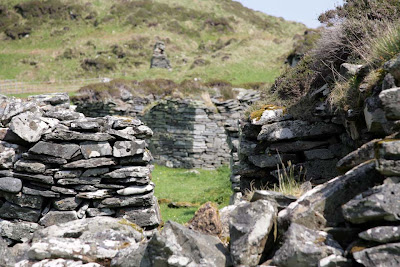
The island has been uninhabited for a thousand years since the Vikings sacked the monastery. Today, even in the spring sunshine, wandering among the ancient stones of Hinba, you are surrounded by echos and ghosts of the past.

Ancient grave stones protrude above the encroaching mosses and grass. Their only markings are the patterns of lichens, which grow in abundance in the clean air. The identities of the occupants of the graves below are unknown but they were our ancestors and like us they were attracted to this necklace of islands to escape the everyday world. Unfortunately for them, 500 years of peaceful meditation were ended by a change in the outside world; the arrival of the Vikings.
To this day St Brendan is the patron saint of seafarers and (dare I say it?) sea kayakers.
